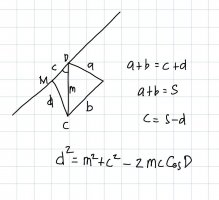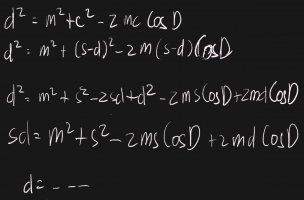Hello, im trying to make equation from a Law of Cossine. I have one triangle with side a, b and m and have all the values and i want to make another triangle using one vector that the direction is making that line c. The new triangle will have side c and d. So the law is a + b = c + d. The only thing that i could think of is Law of cosine, since I know the angle D is and the length of m. So could some one help me to isolate the length of d so i could find c and multiply that with the normalize vector so i could make the new triangle. Im stuck when trying to issolate the formula for d. So i make c = a + b - d and i make a new variable for a + b = s. So what i got is the black background image where i replace c with (s - d). Thanks.
You are using an out of date browser. It may not display this or other websites correctly.
You should upgrade or use an alternative browser.
You should upgrade or use an alternative browser.
Literal Equation Isolate d
- Thread starter ahohohoy
- Start date
Steven G
Elite Member
- Joined
- Dec 30, 2014
- Messages
- 14,383
Any chance you explain why a+b=c+d as I do not see this being true? There are three angles at point D! When you refer to <D which one are you talking about?
Actually based on your own drawing a = sqrt(5), b = 2*sqrt(2), c= sqrt(2) and d= sqrt(5)
You need to explain how you are making this 2nd triangle!
Actually based on your own drawing a = sqrt(5), b = 2*sqrt(2), c= sqrt(2) and d= sqrt(5)
You need to explain how you are making this 2nd triangle!
Last edited:
Dr.Peterson
Elite Member
- Joined
- Nov 12, 2017
- Messages
- 16,087
If I'm reading this correctly,Hello, im trying to make equation from a Law of Cosine. I have one triangle with side a, b and m and have all the values and i want to make another triangle using one vector that the direction is making that line c. The new triangle will have side c and d. So the law is a + b = c + d. The only thing that i could think of is Law of cosine, since I know the angle D is and the length of m. So could some one help me to isolate the length of d so i could find c and multiply that with the normalize vector so i could make the new triangle. Im stuck when trying to isolate the formula for d. So i make c = a + b - d and i make a new variable for a + b = s. So what i got is the black background image where i replace c with (s - d). Thanks.

the LHS should be 2sd. Now gather terms in d by subtracting 2md cos(D) from both sides, factor out d, and divide
This assumes you are right that c+d=s=a+b, and m, s, and D are known, so that your equation is appropriate.
thats what i want to make. So im making a leg using this, and the rule for the leg to works is a+b should be equal to c+d, and i need to find what is the value of d, so i could do c = a +b - d, and find the c value to build the second triangle. D is the angle between m and c, thats the angle that I know currently.Any chance you explain why a+b=c+d as I do not see this being true? There are three angles at point D! When you refer to <D which one are you talking about?
Actually based on your own drawing a = sqrt(5), b = 2*sqrt(2), c= sqrt(2) and d= sqrt(5)
You need to explain how you are making this 2nd triangle!
Oh yeah, it should be 2sd, thanks.yeah, for the leg to move correctly (im making a leg system), a + b should be equal c + d to works. Okay is it what you mean?? Yeah im trying to isolate d = ... , so i could get the c = a + b - d, and could make the second triangle that has the same length along the normal of that long vector of c.If I'm reading this correctly,
View attachment 31722
the LHS should be 2sd. Now gather terms in d by subtracting 2md cos(D) from both sides, factor out d, and divide
This assumes you are right that c+d=s=a+b, and m, s, and D are known, so that your equation is appropriate.
Attachments
Last edited:
Okay it works!!! Thank you so much dr.peterson, i have to learn more about algebra and using factorization.If I'm reading this correctly,
View attachment 31722
the LHS should be 2sd. Now gather terms in d by subtracting 2md cos(D) from both sides, factor out d, and divide
This assumes you are right that c+d=s=a+b, and m, s, and D are known, so that your equation is appropriate.



